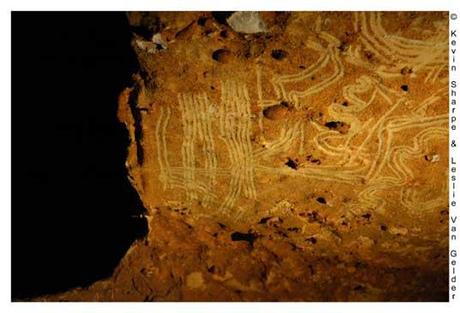There was a time when Paleolithic cave paintings were construed primarily through the lens of “art,” an interpretive stance which assumes that at least some Paleolithic peoples were “artists” who painted for pleasure. Because this lens is so subjective (and creative), all manner of interpretations were offered. Whether prosaic or fanciful, this approach raised troubling questions.
Aside from the usual concerns about over interpretation, some wondered whether there was any justification for assuming that Paleolithic people had an essentially modern aesthetic category which might be called “art.” If they didn’t, it would follow that artistic interpretations of the cave paintings were just that and shed little light on Paleolithic minds.
Frustrated by the sense that we weren’t getting any closer to understanding Paleolithic symbols, some began searching for alternatives. One of the more compelling came from cognitive archaeologist David Lewis-Williams. Having studied rock art around the world, Lewis-Williams noticed that certain kinds of symbols regularly appeared across time and space. This was an enigma, given that the peoples producing these recurring symbols had not been in contact with one another. These symbols were not, in other words, the result of cultural diffusion. Lewis-Williams calls these symbols “entoptic forms”:

We know from ethnography and ethnohistory that in non-state societies, ASC is often the province of shamans. With this in mind, Lewis-Williams argues that entoptic forms are related to shamanic practices. Although we can’t know what kind of cultural meaning the symbols had or were assigned, we could at least link them to ASC and shamans.
If we don’t go any further, the argument is fairly parsimonious and anchored in shared biology. Lewis-Williams, however, goes further. He contends that shamans were largely responsible for the European cave paintings and that access to the caves (and images) was restricted. He sees in this an emerging social complexity and stratification, whereby shamans are privileged and powerful. Although this is plausible it is also speculative. There is little evidence for emerging complexity or stratification in the Upper Paleolithic archaeological record.
While the functional linkage between shamans-ASC-entoptics and ritual surely holds in some or even many cases, it is looking less likely in others. In 2004, Kevin Sharpe and Leslie Van Gelder suggested that 13,000 year old “flutings” inside Rouffignac Cave, France were made by children. In 2006, Sharpe and Van Gelder experimentally confirmed these findings and found that children between 2 and 5 years of age made these markings:

What I’ve found in Rouffignac is that they are screaming to be heard — the presence of children is everywhere in the cave, even in the passages furthest from the entrance. There are no areas in Rouffignac with flutings where we find adults without children, and vice versa.
Many theories about cave art point to shamanism or ritual use. While I don’t rule that out, I don’t think that that’s necessarily the case for all caves. With children involved, it could have been one of those reasons but also very likely could have been play or a time for practicing art, or simply an exploration of the landscape.
If we didn’t know that young children made these markings, it would be tempting to attribute them to shamans experiencing ASC. There are some obvious resemblances between entoptic forms (see chart above) and the childrens’ markings at Rouffignac. While one could argue that the children were shaman apprentices being tutored in ASC and entoptics, this amounts to special pleading. I can’t think of any ethnographic or ethnohistoric instances of children this young being trained as shamans or inducing ASC.
These findings also call into question Lewis-Williams’ contention that deepest, darkest recesses of caves were reserved for the most experienced shamans (with privileged access to the spirit world) undergoing the most intense ASC. If children were in these dark zones, it is hard to argue for restricted access or shamanistic exclusivity.
The most likely or parsimonious interpretation of these symbols is the one given by Cooney: play. If children were doodling “entoptics” in the cave with their parents, it suggests that “artistic” interpretations of these symbols deserve reconsideration. All in all, this research serves as a good reminder that not everything produced by Paleolithic peoples requires a utilitarian or functional explanation.
References:
Lewis-Williams, David, & Dowson, T.A. (1988). The Signs of All Times: Entoptic Phenomena in Upper Palaeolithic Art Current Anthropology, 29 (2), 201-245
Sharpe, Kevin, & Van Gelder, Leslie (2006). Evidence for Cave Marking by Paleolithic Children Antiquity, 80 (310), 937-947





COMMENTS ( 1 )
posted on 19 December at 03:01
do u think u can show the types of cave forms? i am kinda struggling with them